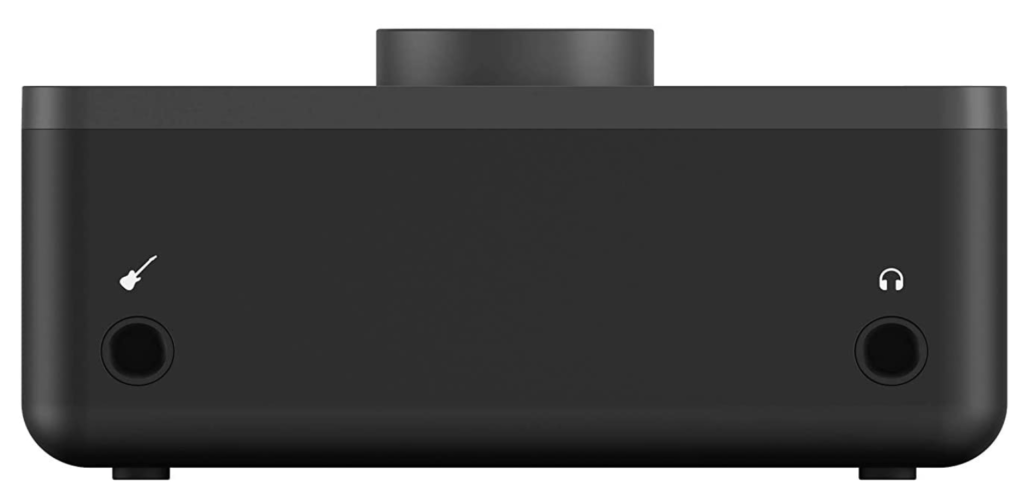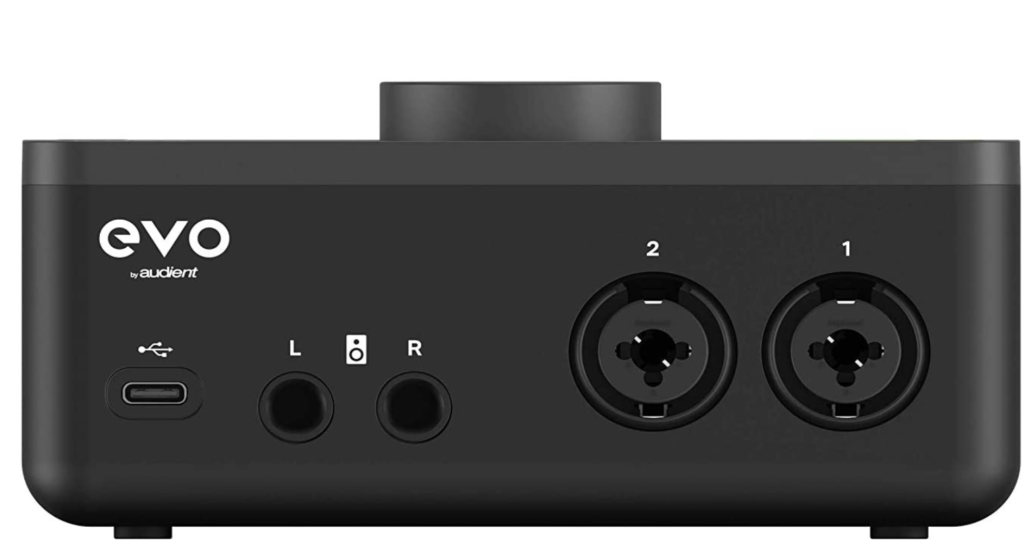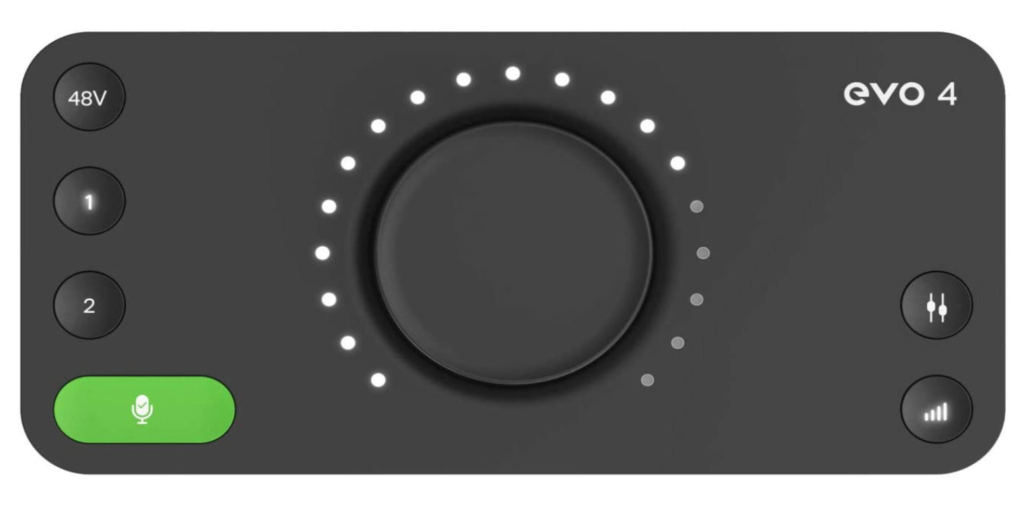Look no further than the Audient EVO 4 for a sleek minimalist audio interface with excellent recording quality.
While it requires a little extra effort, it’s a great option if you’re tired of standard interface designs.
Here’s a complete review of the Audient EVO 4’s recording and design quality.
We’ll also give our take on its preamps, features, software bundle, and more.
Overview
The Audient Evo 4 is a minimalist and affordable audio interface. It features high headroom inputs with a flat frequency response and low-noise transparent preamps with an excellent gain range. You’ll also get some awesome features that you won’t find in most interfaces.
Audient EVO 4 Overall Grade: B+
Build Quality: C
Design Quality: B
Recording Quality: B+
Preamps: B+
Features: A
Software Bundle: A
Who is the Audient Evo 4 is Best for?
The Audient EVO 4 is an interesting option for anyone tired of standard audio interfaces.
When you imagine an audio interface, you picture multiple knobs.
However, the EVO 4 has one knob that controls multiple settings.
While this requires a bit of extra effort, it can make for a unique user experience.
Also, this design makes the EVO 4 very compact and mobile-friendly.
The EVO 4 is best for…
- Anyone looking for an affordable minimalist interface
- Beginners who want help setting gain levels – smart gain feature
- Musicians on-the-go
Notable Features
- Smart gain
- Large multifunctional control knob
- JFET instrument input
- Enable phantom power for each input individually
- Loop back function
Layout and Controls

The front of the EVO 4 features an instrument input and a ¼-inch headphone jack.

On the back, you’ll find a USB-C connection, two ¼-inch outputs, and two XLR/TRS combo inputs.

On the top of the EVO 4 is a large multifunction knob surrounded by a LED level meter.
To the left are two buttons that let you select each channel. From there, you can set the gain and enable phantom power for each input.
By selecting both buttons, you can synchronize the gain for each channel when recording in stereo.
Below we also have a button that activates the smart gain feature.
The top button on the right side lets you control direct monitoring.
Lastly, the button below lets you use the middle knob to control your headphone volume.
Build Quality
Grade: C
We believe the EVO 4 has some room for improvement when it comes to build quality.
The entire outer structure is made of plastic and feels a bit fragile.
Also, its knobs have some wiggle to them.
If you’re looking for a more durable mobile interface in the same price range, the PreSonus AudioBox iOne is a great choice.
[Check out our review of the AudioBox iOne here]
Design Quality
Grade: B
While we prefer a more standard design, Audient’s minimalist approach to the EVO 4 has some benefits.
This little interface will fit perfectly in the corner of your home studio desk.
Also, while it isn’t the most durable, you can easily throw it in the front pocket of your bag and have it wherever you go.
On the other hand, if you’re looking for a simple user experience, this may not be the best choice.
You’ll need to switch between modes to adjust different settings, which is less convenient than other interfaces.
If you’re looking for an interface that’s easier to use for your home studio, try the M-Audio AIR 192|4.
But overall, the EVO is an excellent option if you’re tired of basic interfaces.
It requires a little bit of extra effort, but it’s easy to get used to.
Recording Quality
Grade: B+
- Audio Resolution: 24-bit/96kHz
The mic inputs in the EVO 4 have a relatively flat frequency response with very low distortion.
They also offer an excellent dynamic range of around 115 dB(A) – slightly higher than the Motu M2 and Focusrite Scarlett 2i2.
This high dynamic range will give you plenty of headroom while recording.
You’ll be able to record electric guitars and vocals and worry less about clipping.
[Read more to learn how audio interfaces improve sound quality]
Preamps
Grade: B+
- Gain range: 58 dB
The EVO 4 features transparent low-noise mic preamps that work great with most microphones from our experience.
With an equivalent input noise (EIN) of around -129 dB(A), the EVO 4 can drive low-sensitivity dynamic mics without much preamp noise.
Compared to other interfaces, its noise performance is on par with the Motu M2 and the Focusrite Scarlett 2i2.
[Here’s a list of the 3 audio interfaces with the best preamps]
Features
Grade: A
Smart Gain
A unique feature available with the EVO 4 is smart gain.
By selecting the smart gain button, then selecting an input, the EVO 4 automatically sets the gain for that input.
Smart gain is a convenient function you don’t see in many entry-level interfaces.
Direct Monitoring and Phantom Power
The EVO 4 lets you enable phantom power for each input separately.
Being able to control individual settings for each input adds flexibility when using different mics and instruments at once.
Gain Matching
With gain matching, you can link both channels and simultaneously set the gain for each.
This feature helps match the gain for two mics when recording in stereo.
Loopback Function
Lastly, the EVO 4 has a loopback feature.
When enabled, the EVO 4 records audio from your computer and inputs at the same time.
Overall, it’s hard to find another interface for under $150 with this many features.
Software Bundle
Grade: A
The EVO4 comes with Cubase LE3. It’s an easy-to-use DAW with various recording, editing, and sequencing tools.
Audient also includes some useful plug-ins and instruments. Including M-Tron Pro LE, a digital emulation of Gforce’s classic Mellotron. And Steinberg’s classic analog synth, Retrologue 2.
Also, you’ll get percussion synths and filter plug-ins from Waldorf. Along with a speaker simulator from Two-tone.
Lastly, you’ll have access to the Loopclould sample library and three online courses from Produce Like a Pro.
Overall, this is an excellent software bundle for the price of this interface.
Audio Interface Comparison
Audient EVO 4 vs Audient iD14
The Audient iD14 is a more standard audio interface than the EVO 4.
It has dedicated gain controls for each input. Conversely, the EVO has one multifunctional knob that controls all settings.
This difference in design makes it easier to adjust settings on the iD14 while recording.
When using the EVO, you’ll have first to select a mode before you can adjust levels.
Additionally, the iD14 includes a basic LED level meter that’s decent for setting gain and checking levels.
The EVO 4 is the better option if you’re looking for a more affordable interface.
However, for around $280, the iD14 is an excellent option for both beginner and pro home studios.
Audient EVO 4 vs Audient iD4
Similar to the iD14, the Audient iD4 has a standard design you would expect to see from an audio interface.
However, it doesn’t include a level meter.
Regardless for around $200, it’s a more affordable alternative to the iD14.
Audient EVO 4 vs Audient Evo 8
The Audient EVO 8 is awesome for traveling bands and engineers on the go.
It’s noticeably smaller than your standard 4×4 I/O with dual headphone outputs.
Typically, you don’t see this many I/O in such a compact device.
Overall, the EVO 8’s design makes it an ideal mobile solution, especially if you need to record multiple mics and instruments at once.
Audient EVO 4 vs Motu M2
The Motu M2 is one of the best entry-level audio interfaces.
You’ll also get a loopback feature and an LCD level screen that’s more useful than the level meters on the EVO 4.
Conveniently, both interfaces let you control direct monitoring and phantom power for each input separately.
You’ll get a similar audio performance from each in terms of sound quality.
But overall, the Motu M2 is easier to use.
However, the EVO 4 is an interesting option if you’re looking for an alternative design.
[Check out our review on the Motu M2]
Takeaway: Audient EVO 4 Review
We consider the Audient EVO 4 to be an alternative audio interface.
With most interfaces, you’ll have multiple knobs to adjust levels.
But the EVO 4 has one knob for controlling each setting.
This design makes for a unique user experience that may not be for everyone.
However, if you don’t mind this layout, the EVO has high headroom inputs with a flat frequency response, low-noise transparent preamps, and more features than most entry-level interfaces.








